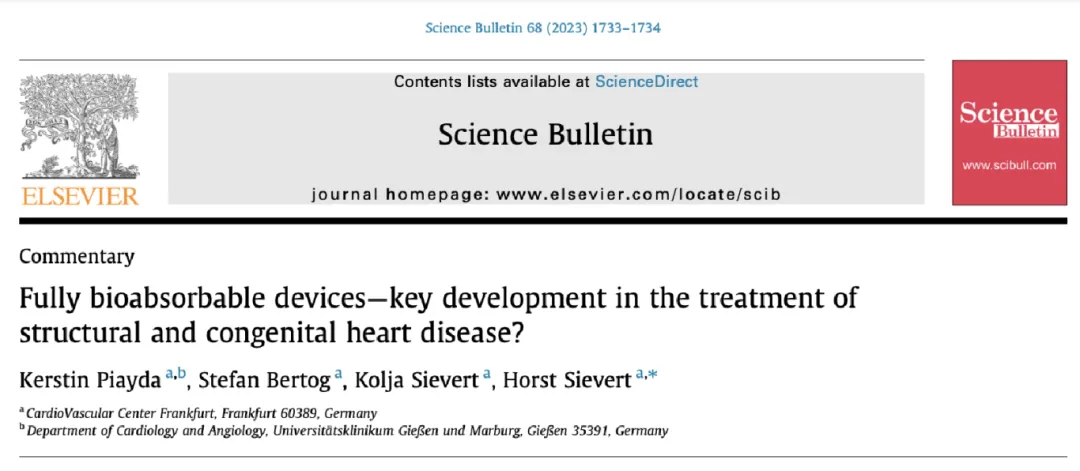生物全降解器械——治疗结构性和先天性心脏病的关键发展阶段?

Kerstin Piayda a,b , Stefan Bertog a , Kolja Sievert a , Horst Sievert a,*
a 法兰克福心血管中心,法兰克福60389,德国
b 德国吉森和马尔堡大学医院心内科,吉森35391,德国
在过去的几十年里,经导管治疗已成为治疗简单先天性心脏病的首要选择,其具有微创和快速恢复的优点。然而,目前使用的金属封堵器可能会导致镍过敏、炎症和磨蚀。在治疗室间隔缺损(VSD)时,由于靠近心电传导组织,植入传统封堵器可能会导致传导异常。使用传统封堵器进行经皮膜周部VSD封堵术的患者中,可能发生高达2%完全房室传导阻滞[1]。该事件的发生时间各不相同,从即刻/术中到术后几年后不等。最常见的是在最初的五天内观察到[1],然而,迟发性房室传导阻滞相当常见。因此,美国FDA尚未批准膜周部VSD封堵器械[2]。室间隔缺损的复杂解剖结构及其与窦房结的解剖关系使器械的设计和开发变得复杂。在这种情况下,生物可降解封堵器具有潜在的优势。可以想象,由于植入物随时间降解和原有心脏组织将其覆盖,周围组织受压迫和持续性心律失常的发生率会较低。
Over the past decades, transcatheter therapy has become the primary option for the treatment of simple congenital heart diseases with the advantages of minimal invasiveness and rapid recovery. However, currently used metal occluders may cause nickel allergies, inflammation, and erosion. In the treatment of ventricular septal defects (VSD), due to the close proximity of the electrical conduction tissue, implantation of conventional occluders may cause conduction abnormalities. Complete atrioventricular block can occur in up to 2% of patients undergoing percutaneous perimembranous VSD closure with conventional devices [1]. The timing of this event varies, ranging from immediate/intraprocedural to years after the procedure. Most commonly, it is observed within the first five days [1], however, late-onset atrioventricular block is fairly common. For this reason, no perimembranous VSD closure device has been approved by the US Food and Drug Administration [2]. The complicated anatomical structure of VSDs and its anatomical relationship to the atrioventricular node complicates device design and development. In this context, bioresorbable occluders have potential advantages. It is conceivable that, due to implant degradation over time and native cardiac tissue coverage, surrounding tissue compression and persistent arrhythmias are less prevalent.
考虑到传统装置的上述局限性,Wang等人[3]报道了一种新型生物全降解封堵器治疗膜周部室间隔缺损的疗效和安全性。108名患者参加了这项非劣效性、多中心、随机试验。患者接受植入了生物可降解封堵器(试验组)或传统的镍钛合金封堵器(对照组)。所有封堵器均成功植入。试验组术后(持续)心律失常的发生率明显降低。通过经胸超声心动图对降解过程进行半定量评估,并判断在24个月随访时完成。未观察到大于2mm的残余分流。作者还证明,封堵器在左心室侧的降解速率更快,这是以前没有报道过的。
Taking the aforementioned limitations of conventional devices into consideration, Wang et al. [3] reported on the efficacy and safety of a new fully bioabsorbable device for the treatment of perimembranous ventricular septal defects. One-hundred-and-eight patients were enrolled in this non-inferiority, multicenter, randomized trial. Patients received either a fully bioabsorbable device (intervention arm) or a conventional nitinol-based device (control arm). All devices were implanted successfully. The incidence of postprocedural (sustained) arrhythmia was numerically lower in the intervention group. The degradation process was semi-quantitatively assessed by transthoracic echocardiography and judged to be completed at 24-month follow-up. No residual shunt >2 mm was observed. The authors also demonstrated that the degradation rate of the occluder was faster on the left ventricular side which has not been reported previously.
作者在这一领域的开创性工作应该受到祝贺。创新的生物医学工程转化为临床实践,并为这种新器械的骨架、编织丝材和设计开发出了独特的材料特性,这看起来克服了以往生物可降解封堵器的一个关键局限性:封堵器降解与不完全内皮化之间的矛盾,以及随之而来的缺损再通。与其他生物可降解和常规器械相比,这种新型封堵器包含两种不同的生物可降解组件,一种具有快速降解速率,另一种具有缓慢降解速率:聚对二氧环己酮(PDO)骨架丝材提供了足够的稳定性,可以在早期(即3个月后)开始降解之前实现完全内皮化,而降解速速率较低的聚乳酸纤维阻流膜则可以防止后期室间隔缺损再通。与金属骨架相比,PDO骨架的弹性较小,封堵器形状由装置左盘内延伸出的成型线维持。然而,PDO丝材具有良好的超声心动图可见度,允许在完全超声心动图引导下植入封堵器。零射线法对本研究人群中的幼儿(平均年龄4岁)特别有吸引力,可以最大限度地减少终身X射线暴露。尤其是对于年轻人中,终身管理很重要。全降解的封堵器可能有能力改变我们的管理方法并提高医疗质量。通过上述提到的技术,可以预防严重的并发症,包括器械磨蚀、穿孔、血栓形成或感染。此外,随着要求经房间隔入路的经导管左侧心脏介入治疗的数量不断增加,开发类似的全降解封堵器来封堵卵圆孔未闭和房间隔缺损,能够满足目前简单的重复经房间隔穿刺的需求。 [4]。任何全降解的技术都有潜在的风险。首先,在脱落造成栓塞的不良事件中,很难定位和取出封堵器,因为它在放射线下不可见。因此,这种封堵器的栓塞可能比传统封堵器的栓塞产生更严重的后果。其次,在封堵器降解过程中形成的新生组织的弹性在长期内可能不足,特别是在腔室之间(即心室之间)存在较大压差的情况下。第三,可以想象的是,“新生组织”不会在生长中的个体中生长和继续封闭缺损部位。第四,尽管最终被新生组织取代,但封堵器可能无法防止对传导组织产生的潜在初始压迫、创伤或炎症。在这一背景下,这里所描述的封堵器械没有产生完全房室传导阻滞是有趣和令人鼓舞的。
The authors should be congratulated for their pioneering work in this field. Innovative biomedical engineering was translated into clinical practice and led to the development of specific material characteristics for the framework, fabric, and design of this new device which appears to overcome a key limitation of previous, bioresorbable occluders: mismatch between device degradation and incomplete endothelialization and consequent defect recanalization. This novel device, as compared with other bioresorbable and conventional occluders, contains two distinct bioresorbable frameworks, one with a fast and one with a slow degradation rate: polydioxanone (PDO) filaments offer enough stability to allow complete endothelialization before it starts to degrade at an early stage (i.e., after 3 months), and the covering poly-L-lactic acid fabric which has a lower degradation rate thereby prevents VSD recanalization at a later stage. As compared with a metal framework, the PDO framework is less elastic and occluder shaping is supported by a shape line on the left disc of the device. However, the PDO filaments have good echocardiographic visibility and allow device implantation under complete echocardiographic guidance. A zero-fluoroscopy approach is especially appealing in young children included in this study population (mean age 4 years), to minimize lifetime X-ray exposure. Especially in the young, lifetime management is important. Fully bioresorbable devices may have the ability to change our management and improve the quality of care. With the here presented technology, serious complications including device erosion, perforation, thrombus formation, or infection might be prevented. Furthermore, with the rising number of transcatheter-based left-sided heart interventions requiring transseptal access, the development of similar fully bioabsorbable occluders for the closure of patent foramen ovale and atrial septal defects potentially allowing uncomplicated repeat transseptal access is an unmet, yet important need, starting to be addressed [4]. There are potential risks related to any fully resorbable technology. First, it will be difficult to impossible to localize and retrieve a device in the untoward event of embolization because it is not radio-opaque. Hence, the embolization of such a device may have more serious consequences than the embolization of conventional devices. Second, the resilience of new tissue formed in the process of device resorption may not be adequate in the long term, especially in the presence of large pressure differences between chambers (i.e., between the ventricles). Third, it is conceivable that ‘‘neo-tissue” will not grow and continue to seal the defect in a growing individual. Fourth, though ultimately replaced by new tissue, it may not prevent potential initial compression, trauma, or inflammation of the conduction tissue. In this context, the absence of complete atrioventricular block with the here-described device is intriguing and encouraging.
总之,Wang等人[3]报告的结果为未来使用生物可降解封堵器封堵VSD提供了有利的证据。该研究详细描述了聚合物降解速率的特征,为后续的器械开发提供了宝贵的经验。此外,这些有前景的研究结果为生物可降解器械的安全性(如残余分流、器械位移或支撑力不足)的讨论提供了进一步的有价值的观点。关于该器械的进一步开发可能包括加强PDO骨架以排除成型线,省略封堵器成型的额外步骤以减少手术时间,以及采用侵入性较小的入路进行试验。重要的是,需要更长的随访来评估长期并发症和封堵的持久性。
In summary, the results reported by Wang et al. [3] provide favorable evidence regarding the future use of bioresorbable devices for VSD closure. The study portrayed detailed characteristics of polymer degradation rate, providing valuable experience for subsequent device development. Furthermore, the promising results offer further valuable points in the discussion regarding the safety of biodegradable devices such as residual shunt, device displacement, or inadequate support. Further developments regarding this device may include strengthening of the PDO framework to exclude the shape-line, omission of additional steps for occluder shaping to reduce procedure time and conduction of a trial with a less invasive access route. Importantly, longer follow-up is needed to assess for long-term complications and durability of closure.
参考文献

Kerstin Piayda
Kerstin Piayda是法兰克福心血管中心的研究助理,也是吉森大学诊所的心脏病学住院医师。她拥有法兰克福歌德大学的医学学位,并于2022年12月在伦敦政治经济学院完成了心血管科学健康经济学、结果和管理硕士学位。她的研究兴趣围绕介入心脏病学和结构性心脏病的临床研究。

Horst Sievert
Horst Sievert 是一名介入心脏病学家,也是法兰克福歌德大学的内科和心脏病学教授。他是法兰克福心血管中心的主任,并作为首席研究员参与了介入心脏病学的几项具有里程碑意义的试验。他的主要临床和研究重点在于先天性和结构性心脏病、心力衰竭和中风高危患者的介入治疗。
可降解学苑精彩内容
MemoSorb®全降解封堵器在PDA病例中的应用及1年长期随访结果分享
经典文献解读|经导管全降解室间隔缺损封堵器:即刻封堵和再生后吸收的深度揭秘
俄罗斯患者远赴中国求医:应用MemoSorb®可降解封堵器治疗大型长隧道PFO
ICE指导MemoSorb®可降解封堵器介入封堵11.33mm长隧道PFO病例分享
MemoSorb®阿联酋首例商用|近主动脉瓣全降解室缺封堵术病例分享
- End -
关注我们
专业的心血管医生学术交流平台


版权及免责声明:
本网站所发表内容知识产权归属医谱平台、主办方以及原作者等相关权利人,未经许可,禁止进行复制、传播、展示、镜像、转载、摘编等。经授权使用,须注明来源,否则将追究其法律责任。有关作品内容、版权和其他问题请与本网联系。

发表留言
暂无留言
输入您的留言参与专家互动